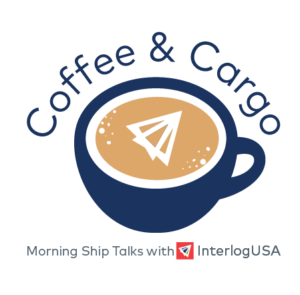Competitive Edge
June 29th, 2022
Stay Current with Interlog’s Weekly Newsletter:
Headlines
- The American Journal of Transportation reports Ceres Terminals announcement of the upcoming opening of a new permanent pop-up container yard nestled in the Greater Houston area. The 75-acre terminal is directly adjacent to the Port of Houston’s Barbours Cut Terminal.
- S. imports from South America remain strong and have put pressure on capacity and rates for the Brazil-U.S. trade lane. The Journal of Commerce reports spot ocean freight rates from Santos, Brazil to New York have rose from $7,400 per forty-foot equivalent unit (FEU) in February to $8,400 per FEU in June. Industry insiders expect further increases to rates in July.
UPDATE: U.S./Canada Ports – Number of Vessels at Anchor as of 06-28-22
- Savannah: 29 Vessels at Anchor (-4)
- Houston: 26 Vessels at Anchor (+10)
- New York/Newark: 16 Vessels at Anchor (0)
- Vancouver: 16 Vessels at Anchor (+1)
- Los Angeles/Long Beach: 13 Vessels at Anchor (0)
- San Francisco/Oakland: 8 Vessels at Anchor (+5)
- Charleston: 0 Vessels at Anchor (-1)
Note: This does not include vessels moored and being unloaded at port docks.
Courtesy: MarineTraffic
IMPORT: Asia to North America (TPEB)
Recent Developments:
- Shanghai has reopened after its two-month Covid-related lockdown. All businesses in the city have resumed work June 1, including manufacturing, production, and warehousing.
- From Triple Eagle (Group) Ltd., manufacturing and production in the city will take “some time” before returning to normal operations.
- With Shanghai opened up, many forecast a surge of pent-up demand will occur pressuring operations and increasing overall rates. However, as of now, it remains unclear to the exact strength of restoring volumes at the port.
- Contract negotiations between the International Longshore and Warehouse Union (ILWU) and Pacific Maritime Association (PMA) remain active. The existing labor contract between the two parties will expire this Friday, July 1.
Rates: Rates remain relatively elevated compared to pre-pandemic levels but continue to see decreases as with opening space. MSC plans to implement GRIs from Indian origins to U.S. destinations in July.
Space: Space is generally open for now, but any surges in demand and volumes will tighten space.
Capacity: Capacity has tightened in pockets. A certain trend of shippers shifting to the USEC has developed due to uncertainty around West Coast (ILWU and PMA) labor talks.
Equipment: Intermodal systems remain stressed with congestion and truck and chassis deficits.
TIPS: Book at least 2-3 weeks prior to ready date. Strongly consider premium services and, if cargo is ready now, make plans to move as soon as possible with the current openings in space and fallen rates.
IMPORT: Europe to North America (TAWB)
Recent Developments:
- USWC ports have seen alleviated congestion and vast improvements to vessel waiting times.
- USEC ports of Savannah and New York/Newark are experiencing significant congestion.
- Recurring challenges with ocean freight have led to higher conversions to air freight among importers.
Rates: Rates remain elevated. What’s been seen in June will likely sustain into July.
Space: Space remains critical for USEC and USWC. However, there have been glimpses of improvements.
Capacity: Capacity for both North Europe and Mediterranean services remain gripped.
Equipment: Equipment remains generally available at European seaports. However, inland terminals in Europe are still reporting equipment shortages.
TIPS: Book 5 or more weeks prior to ready date. Shippers are strongly advised to use premium service for no-roll options and improved reliability for their cargo.
EXPORT: North America to Asia
Recent Developments:
- For the USEC, congestion remains considerable at New York-Newark and Savannah ports.
- Diminished schedule integrity continues to challenge post earliest return dates.
- Stifling vessel backlogs in Shanghai have led to increased occurrences of blank sailings.
- Vessel arrivals remain smooth for USWC POLs.
Rates: Some carriers have issued limited GRIs for July.
Capacity: Available capacity remains fluid for USWC POLs.
Equipment: Truck, container, and chassis availability remain causes for concern and has significantly contributed to congestion of the intermodal system and IPI origins. Standard equipment at ports remains available.
TIPS: Book 4 to 5 weeks prior to time of departure to secure necessary equipment and vessel space.
Did You Know: JAXPORT announces the completion of their $100 million in berth improvements at the SSA Jacksonville Container Terminal (JCT) at Blount Island
Within these improvements features a 47-foot channel depth with 2,400 linear feet of new berthing space that can now handle two post-Panamax container ships.
Additionally, more than $72 million for yard improvement have started to enable the terminal to accommodate 500,000 TEUs annually
Source: American Journal of Transportation
Freight News
Ahead of Peak Season, SC Ports are Implementing Measures for the Port to Continue to be Fluid
The Port of Charleston announced it will remain open for cargo owners on Sundays through the end of September – which is a three-month extension. Additionally, the Journal of Commerce (JOC) reports that port officials believe this is a key measure to help prevent backlogs of vessels throughout peak season.
Lessons were learned for the South Carolina Port Authority. Last February and March the port had to deal with some debilitating congestion. Now, the port is confident that with the extension of Sunday gate hours, leasing out new chassis to cargo owners, organizing container stacks, and continuing to work to ensure a smooth flow of cargo with rail partners, will all help to navigate through peak season with no major issues, the JOC says.
Port of Los Angeles reports half its truck gates have gone unused in the wake of peak season
Officials at the Port of Los Angeles report that more than half of the port’s truck gates are going unused ahead of peak season. The port’s director, Gene Seroka, remarked during normal business hours an average of 53 percent of truck gates are free with truckers preferring to arrive in midday. In return, this results in less activity at other times of operation. His comments are courtesy of the American Journal of Transportation (AJOT).
The port implores how critical it is for truckers to make use of the available time better. While port operators have worked with truckers to smooth out bottlenecks through extended hours in the past year, the coming peak season brings newfound pressure as expected surges in import volumes will flood through America’s busiest container gateway. AJOT notes at the height of supply chain disruptions last year, both southern Californian ports—Los Angeles and Long Beach—implemented 24-hour longshore operations and extended gate hours for trucking.
Matt Schrap, CEO of the Harbor Trucking Association reasons that it is challenging for truckers to parcel off their time for off-peak hours. Other functions of the supply chain, such as distribution centers, typically are not operating around the clock. Understandably, picking up a load from the port at an extended hour may not be in the best interest of a trucker’s schedule if they cannot access other facilities.
Watch this month's webinar!

We discussed import conditions, what the second half of summer looks like/what to expect, current events and had a live Q&A with our experts!
Sign up for our
industry answers
Our team works to provide valuable, unique, and relevant content to assist you in finding solutions. Sign up now.
